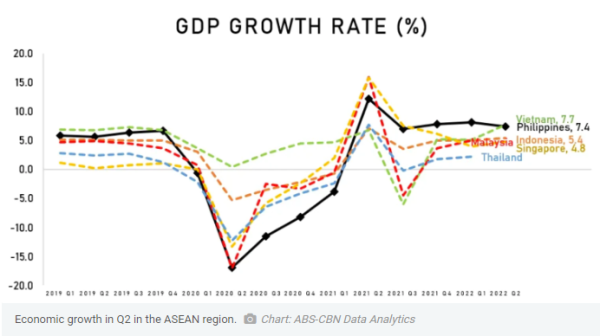[8.9] 필리핀 GDP는 2/4분기에 7.4% 증가했지만 성장은 둔화되었습니다.
컨텐츠 정보
- 16,224 조회
본문
마닐라 (업데이트) - 필리핀 경제가 2분기에도 7.4% 성장하며 반등세를 지속하고 있다고 주 통계국이 화요일에 발표했습니다.
이는 올해 1분기에 발표된 8.2%의 국내총생산 성장률 수정에 이은 것입니다.
필리핀 통계청은 전염병이 한창이던 시기에 국가가 경기 침체에 빠진 이후 이번이 5분기 연속 성장이라고 말했습니다.
아르세니오 발리사칸 사회경제기획부 장관은 2분기 성장률이 그 기간 전망치인 7.5%보다 약간 낮았지만 여전히 아세안의 주요 경제국들 중 두 번째로 높다고 말했습니다.
"우리나라는 베트남의 7.7퍼센트 다음이지만 인도네시아의 5.4퍼센트, 중국의 0.4퍼센트보다 빠릅니다," 라고 국가경제개발청장이기도 한 "발리사칸"이 말했습니다. 하지만, 경제 성장도 1분기보다 둔화되었다고 PSA는 말했습니다.
내셔널 스태틱스의 데니스 마파(Dennis Mapa)는 "계절 조정된 국민계정에서 2022년 2분기 GDP는 분기 대비 -0.1% 감소했다"고 밝혔습니다.
"저는 세계적인 역풍, 특히 인플레이션, 수입 인플레이션, 에너지 연료 및 식품이 눈에 띄게 둔화된 데 기여했다고 생각합니다. 그러나 우리는 올해 남은 기간 동안 재방문한 계획 또는 목표에서 이러한 발전을 고려했습니다."라고 "Balisacan"은 말했습니다. 분석가들은 또한 이것이 로이터 통신의 여론 조사에서 예측된 8.6 퍼센트를 훨씬 밑도는 것이라고 지적했습니다.
ING 은행 수석 이코노미스트 "Nicholas Mapa"는 탄탄한 가계 소비가 정부의 부드러운 지출, 줄어드는 기저 효과, 그리고 심각한 무역 적자로 상쇄될 가능성이 높다고 말했습니다.
그는 또한 인플레이션 상승과 정부의 재정적 핸디캡으로 인해 하반기에는 성장이 더 둔화될 수도 있다고 경고했습니다.
하지만 단기적으로 소비에 영향을 미칠 수 있는 금리 인상은 전반적인 회복에 장기적인 이익을 위해 봐야 한다고 '발리사칸'은 말했습니다.
"저는 정책 변화가 경제에 긍정적인 영향을 미칠 것이라고 믿고 싶습니다,"라고 그는 말했습니다.
BPI 리드 이코노미스트 "준 네리"는 4월과 5월 초의 선거 관련 지출이 어느 정도 산출량을 완화시켰다고 말했습니다. 하지만, 그는 상품 가격이 2월부터 6월까지 급등하지 않았다면 성장률이 훨씬 더 빨라졌을 것이라고 말했습니다.
"마파"는 1분기에 상당 부분을 차지했기 때문에 2분기에 선거 지출의 일부만 포함되었다고 덧붙였습니다.
지난해, 코로나19 규제가 약간 완화되면서 한국의 GDP 성장률은 12.1%로 반등했습니다. 2020년, 많은 산업과 부문이 질병의 확산을 억제하기 위해 문을 닫으면서 경제는 -16.9 퍼센트의 역사적인 최저로 축소되었습니다.
PSA는 2분기 GDP 성장이 주로 도소매 무역의 확대, 자동차와 오토바이의 수리, 건설, 운송과 보관에 의해 주도되었다고 말했습니다.
"농업, 임업, 어업, 산업, 서비스 등 주요 경제 부문은 2022년 2분기에 각각 0.2%, 6.3%, 9.1%로 모두 플러스 성장을 기록했습니다."라고 기관은 덧붙였습니다.
PSA는 또한 정부 소비가 11.1퍼센트 증가한 반면, 가계 소비는 8.6퍼센트 증가했다고 언급했습니다. 수출도 증가했지만 여전히 수입보다 앞섰습니다.
경제 관리자들은 올해 GDP가 인플레이션과 금리 상승으로 7퍼센트에서 8퍼센트로 떨어진 6.5퍼센트에서 7.5퍼센트로 성장할 것으로 예상하고 있습니다.
"발리사칸"은 이 나라의 강력한 성장을 경제 개방과 발병의 효과적인 관리 덕분으로 돌렸습니다.
"올해 남은 기간 동안 우리는 동일하거나 더 나은 위험 관리 프로토콜을 적용하고 높은 인플레이션과 다른 충격, 코로나19로 인한 상처로부터 가장 취약한 사람들을 보호해야 합니다."라고 "Balisacan"은 말했습니다.
그는 2분기에는 성장이 "그렇게 빠르지 않을 수도 있다"고 말했지만, 여전히 올해의 목표인 6.5퍼센트에서 7.5퍼센트에 도달할 것 같습니다.
7.5%의 누적 성장을 이루기 위해서는 하반기에는 7.2%의 경제성장이 필요하다고 그는 말했습니다.
그는 정부가 대면 수업의 복귀를 포함하여 한국을 완전히 재개할 것을 약속한다고 말했습니다.
"네, 앞으로의 길은 어렵지만 극복할 수 있습니다,"라고 그는 덧붙였습니다. PSA는 6월에 실업률이 6퍼센트로 안정되어 있는 반면, 50만 명 이상의 새로운 필리핀 근로자들이 일자리를 구했다고 일찍이 보고했습니다.
This is the Original Article from ABS-CBN NEWS
MANILA (UPDATE) - The Philippine economy continues its rebound, growing 7.4 percent in the second quarter, the state statistics bureau said on Tuesday.
This follows the revised 8.2 percent gross domestic product growth rate posted in the first quarter of the year.
The Philippine Statistics Authority said this was the 5th consecutive quarter of growth since the country went into recession during the height of the pandemic.
Socioeconomic Planning Secretary "Arsenio Balisacan" said the Q2 growth rate was slightly lower than the 7.5 percent forecast for the period but was still the second-highest among the major economies of ASEAN.
“Our country is next to Vietnam’s 7.7 percent but faster than Indonesia’s 5.4 percent and China’s 0.4 percent,” said "Balisacan" who also heads the National Economic and Development Authority. However, economic growth also slowed from the first quarter, the PSA said.
"In the seasonally-adjusted national accounts, the second quarter 2022 GDP fell -0.1 percent quarter on quarter," said National Stastician "Dennis Mapa".
"I think the global headwinds, particularly inflation, imported inflation, energy fuel and food contributed to the noticeable slowdown. But…we have taken into account such development in our revisited projection or target for the rest of the year," "Balisacan" said. Analysts also noted that this was well below the 8.6 percent median forecast in a Reuters poll.
ING Bank Senior Economist "Nicholas Mapa" said solid household consumption was likely offset by soft government spending, fading base effects and a deep trade deficit.
He also warned that growth may further decelerate in the second half due to inflation rising interest rates and the government’s fiscal handicap.
But interest rate hikes, which could have a short-term effect on consumption, should be seen for their long-term benefits to the overall recovery, "Balisacan" said.
"I’d like to believe that the policy change will have a net positive effect on the economy," he said.
BPI Lead Economist "Jun Neri" said election-related spending in April and early May provided some output cushion. However, he said the growth rate could have been a lot faster if commodity prices had not surged from Feb to June.
"Mapa" added that only a small portion of election spending was included in the second quarter since the bulk has been accounted for in the first quarter.
Last year, the country's GDP growth rate rebounded to 12.1 percent after COVID-19 restrictions were slightly eased. In 2020, the economy shrank to a historic low of -16.9 percent as many industries and sectors were closed to curb the spread of the disease.
The PSA said second-quarter GDP growth was driven mainly by the expansion of wholesale and retail trade; repair of motor vehicles and motorcycles, construction, and transportation and storage.
“Major economic sectors, namely: Agriculture, forestry, and fishing, Industry and Services all posted positive growths in the second quarter of 2022 with 0.2 percent, 6.3 percent, and 9.1 percent, respectively,” the agency added.
The PSA also noted that household consumption grew by 8.6 percent, while government consumption grew 11.1 percent. Exports also grew but were still outpaced by imports.
Economic managers are expecting GDP to grow between 6.5 to 7.5 percent this year, down from 7 to 8 percent amid rising inflation and interest rates.
"Balisacan" credited the country’s strong growth to the opening up of the economy and the effective management of the outbreak.
“For the remainder of the year, we must apply the same or even better risk-management protocols and protect the most vulnerable against high inflation and other shocks, and scarring due to COVID-19,” "Balisacan" said.
He said growth "may not be as fast" in the second quarter but is still likely to hit the target of 6.5 to 7.5 percent for the year.
To achieve a cumulative 7.5 percent growth, the economy needs to grow by 7.2 percent in the second half of the year, he said.
He said the government is committed to fully reopening the country including the return of face-to-face classes.
“Yes the road ahead is difficult, but it is surmountable,” he added. The PSA earlier reported that while the unemployment rate remained steady at 6 percent in June, more than half a million new Filipino workers had found jobs.
관련자료
-
이전
-
다음




